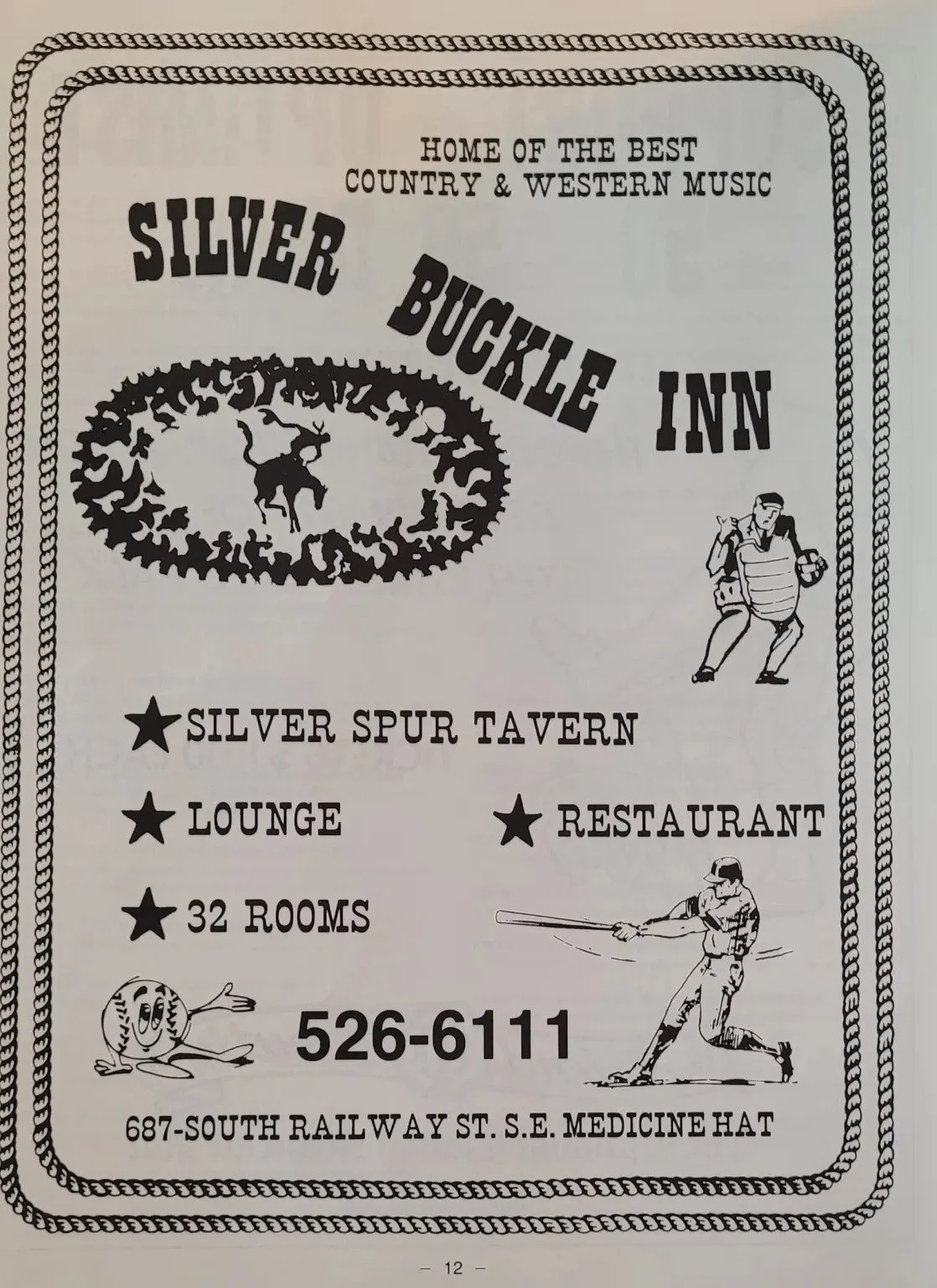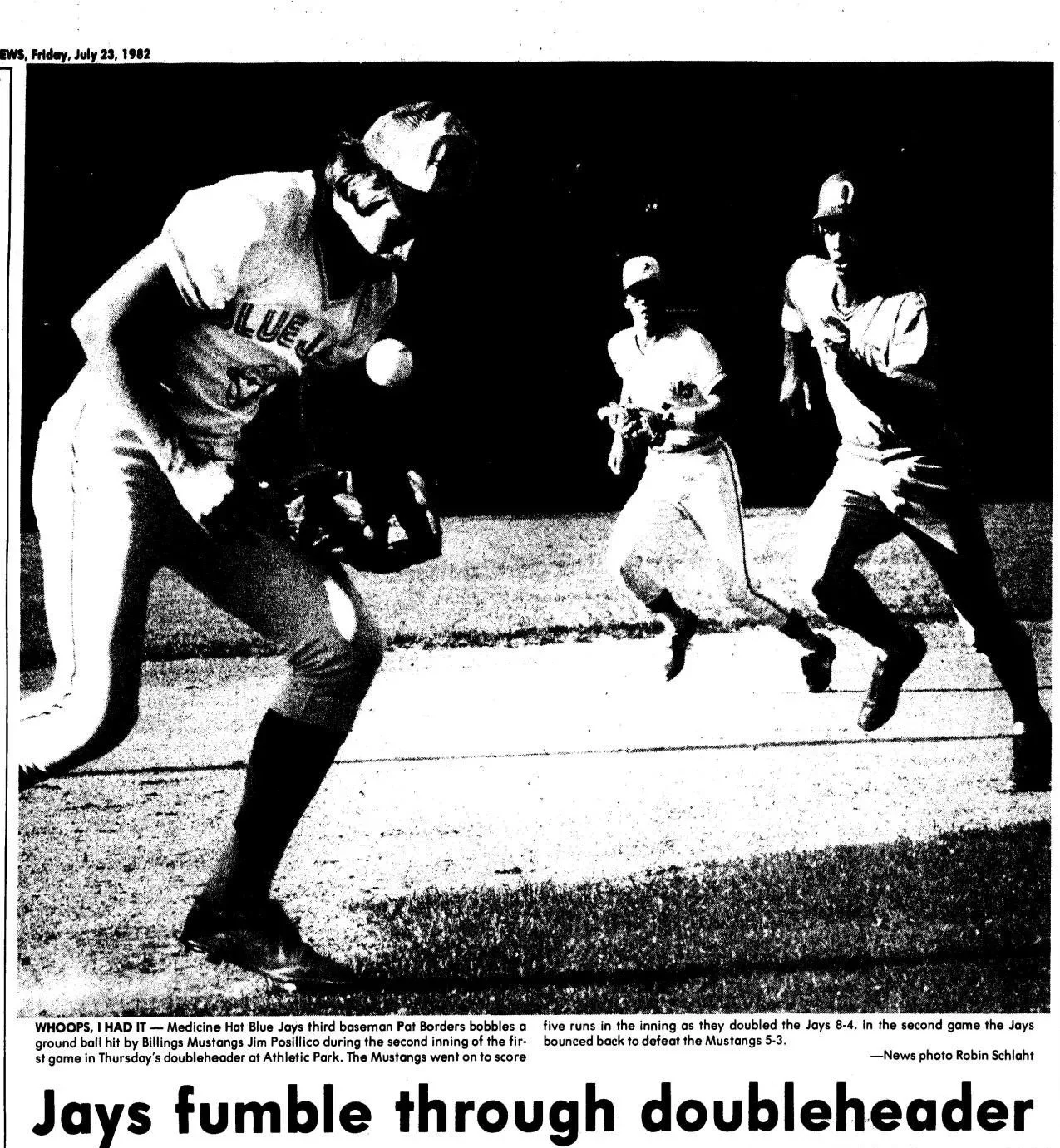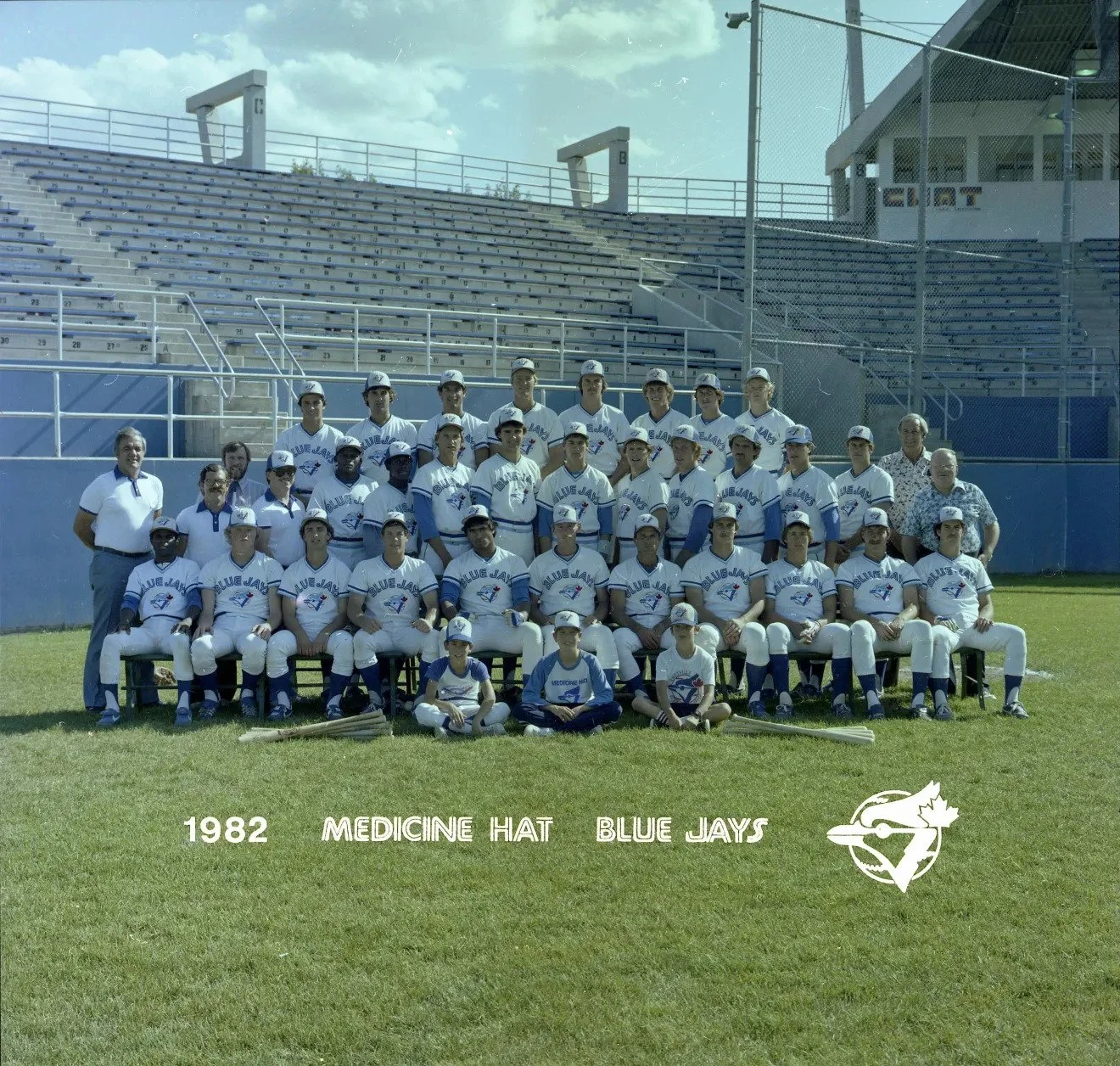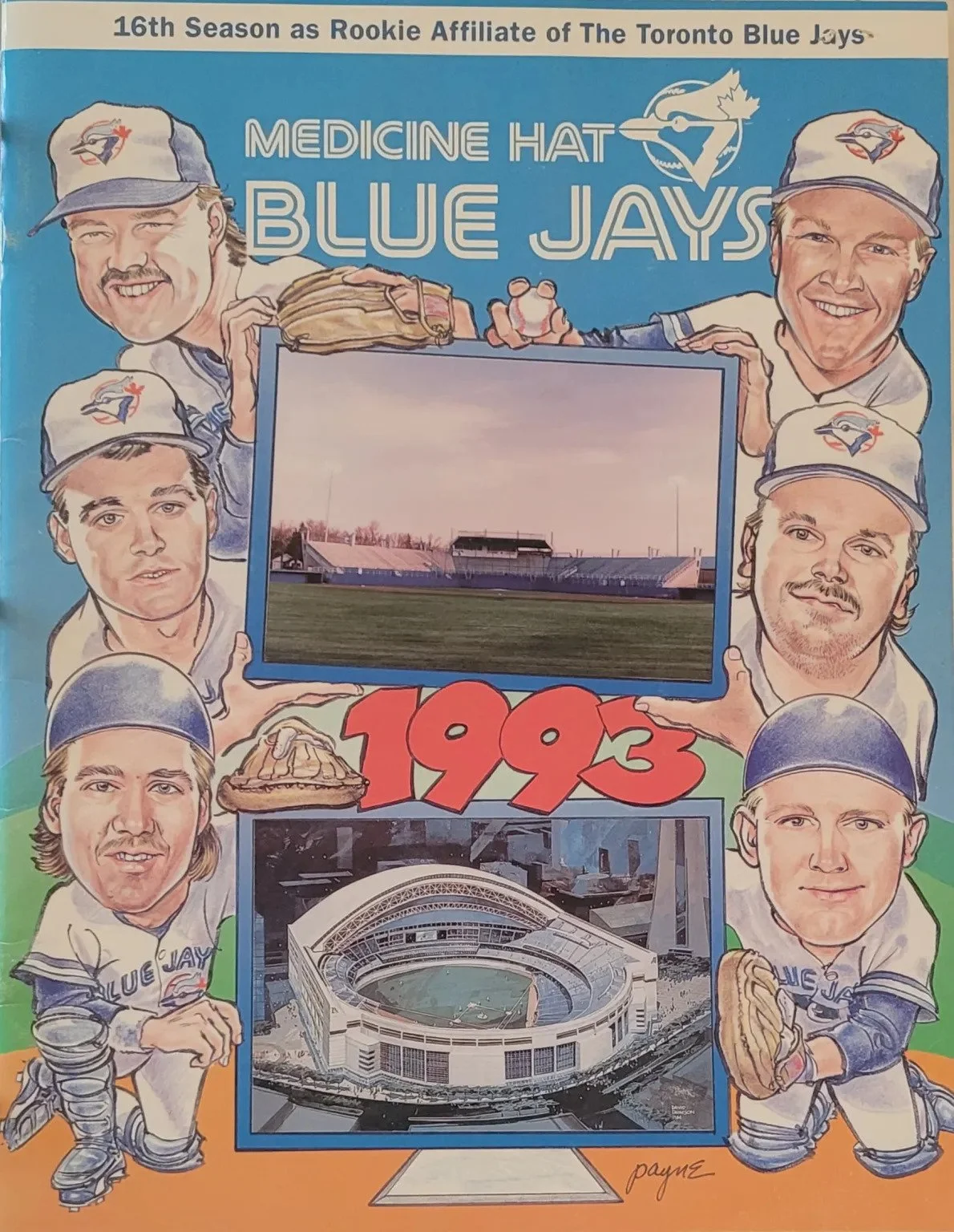Wilson: Jays’ World Series MVP Borders began pro career in Medicine Hat
Pat Borders receives the World Series MVP Trophy in 1992.
*This article was originally published on Alberta Dugout Stories on October 29, 2024. You can read it here.
November 1, 2024
By Ian Wilson
Alberta Dugout Stories
Booted baseballs, hotel hijinks and rowdy road trips punctuated their pursuit of the pennant.
These were the star-studded Medicine Hat Blue Jays of 1982 and Pat Borders was right in the middle of it all.
The sixth-round draft pick from Florida moved to Alberta right after high school and his awareness of Toronto, let alone Medicine Hat, was limited.
“The Blue Jays were completely off the radar. I didn’t know who they were,” admitted Borders during a 2024 visit to Calgary.
“Now you’ve got to go to Alberta, Canada. I’ve got to figure out where Alberta is because high school kids weren’t really paying too much attention to Western Canada, let alone Alberta. So, I got up there and I had a great time, one of the most entertaining times.”
—————————————————————————————————————————————————————————————————-
Listen to Alberta Dugout Stories interview Pat Borders here.
—————————————————————————————————————————————————————————————————-
Borders caught the attention of his manager, Duane Larson, shortly after he took the field at Athletic Park.
During a preseason inter-squad game on June 19th, Larson singled out the hitting performances of Borders, as well as first overall draft pick Kash Beauchamp.
“At this stage of the season the pitchers have a big advantage … a lot of the hitters haven’t seen live breaking balls for a while. It will take them some time to catch up,” Larson told Medicine Hat News reporter Ed Willes.
“I did see a couple things that pleased me. Pat Borders didn’t hit the ball real hard but he looked like he was right on some pitches.”
His play in the field was another story.
The team’s Pioneer League season began on the road in Helena, Montana, where the Phillies got the jump on the Baby Jays due to a fielding error by Borders, who began his career at third base.
A two-out grounder to Borders in the opening inning resulted in a wild throw that missed first baseman Chris Johnston. That allowed Helena to strike for three runs en route to an 8-5 victory over Medicine Hat. To make matters worse, Borders was 0-for-3 in the season opener.
The rookie-level squad bounced back with three straight wins, including a 4-3 road win over the Great Falls Giants that saw Borders exact a measure of redemption for his costly error from the first game.
In front of 3,401 fans at Legion Field, the 6-foot-2 righty slugger stepped to the plate in the 12th inning and delivered a game-winning RBI in the form of a single that scored Johnston.
When the Blue Jays returned for their home opener against the Billings Mustangs on June 28th, they were rolling. Borders kept that going when he drew a bases-loaded walk that scored the first run of the game in the bottom of the second inning. Medicine Hat tacked on two more runs against lefty Tom Browning – who went on to become a fixture in the Cincinnati Reds starting rotation for a decade in the 1980s and 1990s – and Jimmy Key held the Mustangs to two earned runs over seven innings of work as the Blue Jays secured a 3-2 win and boosted their record to 6-1 during the early days of the season.
“It was a wonderful environment. I couldn’t ask for a better situation coming out of high school,” said Borders of his first pro campaign.
“We had some good talent. We had some guys who played in the big leagues and played for a long time. You had a really good environment to create a team, which I think sometimes is overlooked.”
GETTING BUCKLED
That environment included the Silver Buckle Inn, which was home to all the players on the roster.
“That was where we all stayed and it was like a college dorm. We would see each other, be around each other … sometimes fall asleep in the same room watching TV or playing cards, whatever it may be. We had an absolute good time,” recalled Borders.
Advertisement for the Silver Buckle Inn from the 1984 Medicine Hat Blue Jays program.
Teammate David Wells – a starting pitcher who had an MLB career that spanned two decades – provided a more detailed account of the accommodations in his 2004 autobiography, entitled Perfect I’m Not: Boomer on Beer, Brawls, Backaches, and Baseball.
“All of us bunked, two to a room, in that town’s Silver Buckle Hotel. Located just across the street from a hustling, bustling, diesel-scented, eardrum-rattling freight train hub,” wrote Wells.
“Just four stories tall, the Silver Buckle scattered us Blue Jays throughout the second floor. One story down was the hotel lobby, the front desk and a big, kick-ass hotel bar, which featured live music most every night.”
The southpaw expanded on the college dorm atmosphere described by Borders.
“The ritual ran like clockwork. Just after our game, we’d hook up in the hotel lobby, pool our money, then head out to the nearest liquor store, where we’d buy 10, or 12, or 15 cases of bottled beer. Next, we’d lug ’em all up to the top floor of the hotel. Then we’d climb out a window and drag our foamy party supplies onto the roof. Out there, amid the Silver Buckle’s air-conditioning condensers and fry-cooker vents, we’d relax, bond, and get royally ripped. Maybe 75 by 150 feet, that barren little rectangle became sacred ground,” said Wells.
“Redecorating began almost immediately. We’d steal tables and chairs from the hotel bar, then drag ’em all up on the roof. We brought candles and coolers and boom boxes out there too. In time, hundreds of our empty beer bottles, lovingly arranged atop the four-foot cement wall that surrounded the roof, would add a nice, homey finishing touch. Some guys loved it so much out there on the roof, they’d actually drag their mattresses up the elevator, down the halls, and out the window so they could bed down under the stars.”
Despite the team’s penchant for partying, they could play ball.
Their Pioneer League opponents took notice, as did the home fans.
Blue Jays boosters showed up in a big way on Sunday, July 11th when a crowd of 3,688 attended a game at Athletic Park that saw Great Falls defeat Medicine Hat 4-3 in extra innings. The turnout set a league record for single-game attendance that was previously held by Billings.
“The fans here are great and have really supported us. It makes those long bus rides a little more tolerable for the kids when they come home to a reception like this,” noted Larson.
Borders’ two-out error – one of five committed by the home team – in the 12th inning allowed the winning run to score.
“We just gave it away,” said Larson after the game.
The fielding miscues that plagued Borders were noticeable to coaches and teammates alike.
Pat Borders led the Medicine Hat Blue Jays in errors as a third baseman with the team in 1982. This clipping from the July 23rd edition of the Medicine Hat News captures one of his fielding mistakes.
In his book, Wells was complimentary of the Ohio-born infielder’s hitting, but scathing when recalling his work with a glove.
“Offensively, we Blue Jays are led by the bats of Chris Johnston, who leads the Pioneer League in RBIs, and by a good-looking klutz named Pat Borders. Pat’s a tough guy, but with manos de piedra (hands of stone) he’s forever booting routine grounders to third into the visitor’s dugout,” wrote Wells.
“In the outfield, where he’s moved to minimize his potential for error, he loses balls in the sun, even during night games. Pat could hit like an absolute son of a bitch, but we just couldn’t seem to find him a position.”
Borders finished the season with a team-high 25 errors and an .826 fielding percentage that was the worst on the club. In his 61 games, he also batted .304 with a .377 on-base percentage, 12 doubles, 33 RBIs and 30 runs.
FLEX APPEAL
Despite the overthrows and the poor play on the diamond, Borders used his bat to make amends.
During a July 29th contest against the Lethbridge Dodgers, he went off for a trio of three-run homers in three consecutive at bats to lead the Baby Jays to a 15-5 beatdown victory over their southern Alberta rivals that vaulted them into first place in the Northern Division.
Borders nine-RBI outburst included his first home runs as a pro.
“I was always a home-run hitter in high school,” Borders told the News.
“But I just haven’t been getting the ball in the air. Tonight was one of those nights though, I got some fastballs up and hit them.”
Larson was excited to see his top hitter finally breakout.
“I always knew he was strong enough to hit balls out. He was getting good wood on balls earlier but hitting line drives,” said Larson.
“I tell you though, I feel Pat Borders is the best major-league hitting prospect in our lineup.”
The game got heated during the 134th overall draft pick’s third at bat, which saw him face lefty Francisco Veliz. Following an inside pitch, the two had words and the benches emptied. A brawl was avoided and Borders then parked a Veliz offering over the right centre-field fence at Athletic Park.
“After the pitch, he came near home and I asked him if he was trying to hit me. He said something back in Spanish, I said something back, then everybody came rushing out,” said Borders of the tense exchange.
“I was really hyper after that though. That last one really gave me a good feeling.”
Borders was starting to get noticed for the right reasons.
Bobby Mattick, the director of baseball operations for the Toronto Blue Jays, cited Borders and Johnston as two Medicine Hat players he was impressed by during an early-August visit.
“I think this club here has a lot of kids with good makeup,” Mattick told Medicine Hat News columnist Jeremy Cato.
“It’s important at any level, but you start to see it crop up down here.”
Added Mattick: “You can’t knock talent … you have to love that. But talent is pretty obvious. You like to think you can tell if a player’s got good makeup, but a lot of it’s up to the individual. It’s tough to grind it out day after day. You’ve got to have a certain mental toughness about you. It can be developed a little later, but usually it crops up down here.”
That toughness was tested at the end of August when Borders was struck in the face by a ground ball that took a bad hop during the third inning of an 8-2 win over Lethbridge at Henderson Stadium. He was taken to hospital for observation.
POSTSEASON PLAY
Borders recovered and contributed to Medicine Hat’s playoff push, which culminated in a best-of-five Pioneer League championship series against outfielder Jose Canseco and the Idaho Falls A’s in early September.
After missing the series opener – an 8-6 win for the Jays in Idaho Falls – Borders registered a hit, a run and an RBI while playing error-free ball at third base during a 7-4 loss in the second game.
When the action shifted to Athletic Park, Medicine Hat needed two more wins to secure the first title in franchise history.
Borders served as designated hitter and batted sixth in the third game and, despite not contributing to the offence, the Blue Jays won a tight 3-2 game thanks to solid pitching from Derrick Ruetter, Chris Phillips and Dan Gorden.
Back at third base for Game 4, Borders remained snake bitten at the plate and went 0-for-4. But he was dependable defensively and his teammates slapped around 12 hits while ace Keith Gilliam turned in a complete game gem that secured a 6-1 victory and a championship for Medicine Hat.
“It was a nice blend of really good players, high level players. No wonder we won. We had good talent but, once again, taking things back to the Silver Buckle, that pulled us all together,” said Borders.
“It was one of the closest teams. It would more than rival the (Toronto Blue Jays) teams that we won with in ’92 and ’93, and I think that was a big reason why we won because we were so close with each other on and off the field. Just became very close and I still keep in touch with most of those guys now.”
One of those close connections developed with Beauchamp, who advanced as high as triple-A but couldn’t crack a major-league roster despite his status as a first overall pick.
“One of my best friends in my life, which started in Medicine Hat, is Pat Borders. Pat, when he got to the big leagues, he said, ‘Why don’t you come up to New York City and see me for a series?'” Beauchamp told Alberta Dugout Stories: The Podcast.
————————————————————————————————————————————————————————————————
Listen to the Alberta Dugout Stories podcast episode about the 1982 Medicine Hat Blue Jays.
————————————————————————————————————————————————————————————————-
The outfielder took him up on his offer and was surprised at what he saw.
“It was different in the big leagues when he was there. We went to the restaurant to eat and there’s five different players sitting at five different tables. That would’ve never happened in Medicine Hat. We did everything together,” said Beauchamp.
TAKING THE WORLD SERIES BY STORM
After experiencing success in the Pioneer League, Borders rose through the minor-league ranks, as did Wells and Key.
He continued working as a corner infielder – jumping from third base to first base – through the 1985 season with the High-A Kinston Blue Jays, before converting to a catcher in 1986.
Borders broke through with Toronto in 1988 and achieved the ultimate prize in baseball when he claimed back-to-back World Series championships with the Blue Jays in 1992 and 1993.
Cartoon from the cover of the 1993 Medicine Hat Blue Jays program, which featured Pat Borders (bottom left), Jimmy Key (middle left), Mark Eichhorn (top left), Mike Timlin (top right), David Wells (middle right) and Randy Knorr (bottom right).
Wells, who won the first World Series ring alongside Borders and Key, described the backstop’s ascent to MLB stardom in his book.
“In an evolution that surprised us all, Pat would slowly emerge as one of the very best catchers in the major leagues, ultimately becoming Toronto’s MVP in the 1992 World Series,” wrote Wells.
During his six games against the Atlanta Braves in the 1992 Fall Classic, Borders batted .450 with three doubles, a homer, three RBIs and two runs scored.
Borders remained with the Blue Jays until 1994 and kept playing until 2006. After leaving Toronto he split time between triple-A and the major leagues. When he was part of the Seattle Mariners organization in the early 2000s, his games with the Tacoma Rainiers of the Pacific Coast League (PCL) brought him back to Alberta for matchups against the Calgary Cannons and the Edmonton Trappers.
His 17-year MLB career included 1,099 games, a .253 batting average and a .988 fielding percentage.





